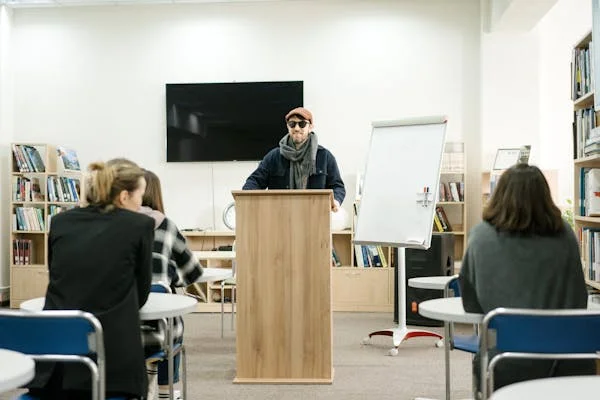Student engagement is a critical factor in the effectiveness of education. When students are engaged, they are more likely to participate in class, retain information, and perform well academically. An engaged student is not just passively receiving information but is actively involved in the learning process. This active participation is key to fostering a deeper understanding of the material and developing critical thinking skills.
As educators, it’s essential to explore various strategies that can enhance student engagement in the classroom, creating a more dynamic and effective learning environment.
1. Incorporate Interactive Activities
Interactive activities are one of the most effective ways to boost student engagement. When students are actively involved in their learning, they are more likely to stay focused and retain the information being taught. Group work, discussions, and hands-on projects are all excellent ways to incorporate interaction into the classroom.
Group work allows students to collaborate with their peers, encouraging the exchange of ideas and perspectives. This not only helps students learn from each other but also fosters a sense of community within the classroom. Discussions, whether in small groups or as a whole class, provide an opportunity for students to voice their opinions and ask questions, making the learning experience more personal and relevant. Hands-on projects, such as experiments or creative assignments, engage students by allowing them to apply what they’ve learned in a practical context. These activities make learning more enjoyable and help students connect theory to practice.
2. Relate Content to Real-Life Scenarios
Students are more likely to engage with material that feels relevant to their lives. When educators relate classroom lessons to real-life scenarios, it helps students see the value in what they’re learning and how it applies outside of the classroom. This approach makes the content more relatable and interesting, which can significantly boost engagement.
Educators with education degrees are often trained to incorporate real-life applications into their teaching strategies. For instance, a math teacher might relate a lesson on budgeting to real-world financial planning, or a science teacher might connect a lesson on ecosystems to local environmental issues. By making these connections, students can better understand how the concepts they are learning will be useful in their everyday lives. This relevance can ignite curiosity and motivation, leading to deeper engagement with the material.
3. Use Technology as a Teaching Tool
In today’s digital age, technology can be a powerful tool for enhancing student engagement. Educational apps, online resources, and interactive whiteboards can make learning more dynamic and interactive. When used effectively, technology can cater to different learning styles and provide students with a variety of ways to engage with the material.
For example, educational apps can turn learning into a game, making it more fun and motivating for students. Online resources like videos, simulations, and interactive tutorials can provide additional support for visual and auditory learners. Interactive whiteboards allow teachers to create dynamic lessons that can be adjusted on the fly, keeping students interested and engaged. By integrating technology into lessons, educators can create a more interactive and personalized learning experience that appeals to today’s tech-savvy students.
4. Foster a Positive Classroom Environment
A positive classroom environment is crucial for student engagement. When students feel that someone cares about them, they are more likely to participate in class and take risks in their learning. Creating an inclusive and encouraging atmosphere where all students feel welcome and respected is essential for fostering engagement.
To create a positive environment, teachers can start by building strong relationships with their students. This involves getting to know each student individually, showing genuine interest in their well-being, and being approachable. Establishing clear expectations and consistently enforcing them helps create a structured environment where students know what is expected of them. Additionally, recognizing and celebrating students’ successes, no matter how small, can boost their confidence and motivation to engage in the learning process.
5. Encourage Student Choice
Giving students some control over their learning can significantly enhance engagement. When students have a say in what they learn or how they demonstrate their understanding, they are more likely to be motivated and invested in the process. Providing choices in assignments, topics, or learning activities can foster a sense of ownership and responsibility.
For example, teachers can offer students a selection of topics for a research project or allow them to choose between different types of assignments, such as writing an essay, creating a presentation, or making a video. This flexibility allows students to play to their strengths and interests, making the learning experience more enjoyable and relevant to them. By giving students a voice in their education, teachers can help them feel more connected to the material, leading to increased engagement and better learning outcomes.
6. Implement Formative Assessments
Formative assessments are a powerful tool for enhancing student engagement by providing ongoing feedback and allowing teachers to gauge student understanding throughout the learning process. They are conducted frequently throughout the learning process to pinpoint areas where students might require extra assistance, unlike summative assessments that measure student learning at the conclusion of a course or unit.
Using formative assessments, such as quizzes, quick polls, or exit tickets, can keep students engaged by encouraging them to stay on top of the material. These assessments also give students a sense of progress, as they can see how they are improving over time. Moreover, when students receive timely feedback, they can correct misunderstandings and feel more confident in their abilities. This continuous loop of feedback and improvement fosters a more interactive and responsive classroom environment.
To truly enhance student engagement, educators must be willing to experiment with different strategies and adapt to the needs of their students. The key is to create a classroom environment that is both stimulating and supportive, where students feel motivated to participate and are encouraged to take an active role in their learning. By focusing on engagement, teachers can help students develop a deeper connection to their education, ultimately fostering a more meaningful and enriching learning experience.





